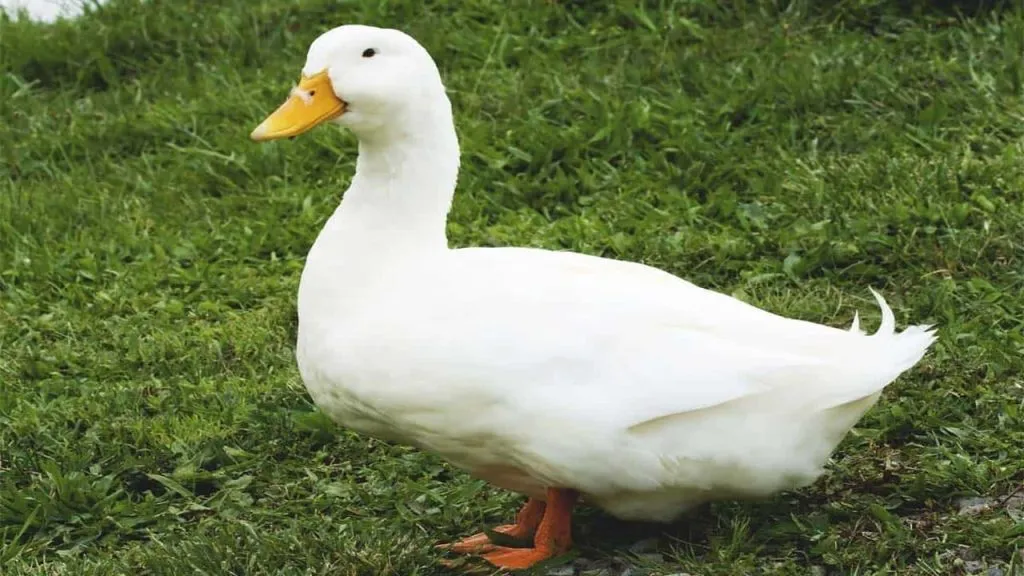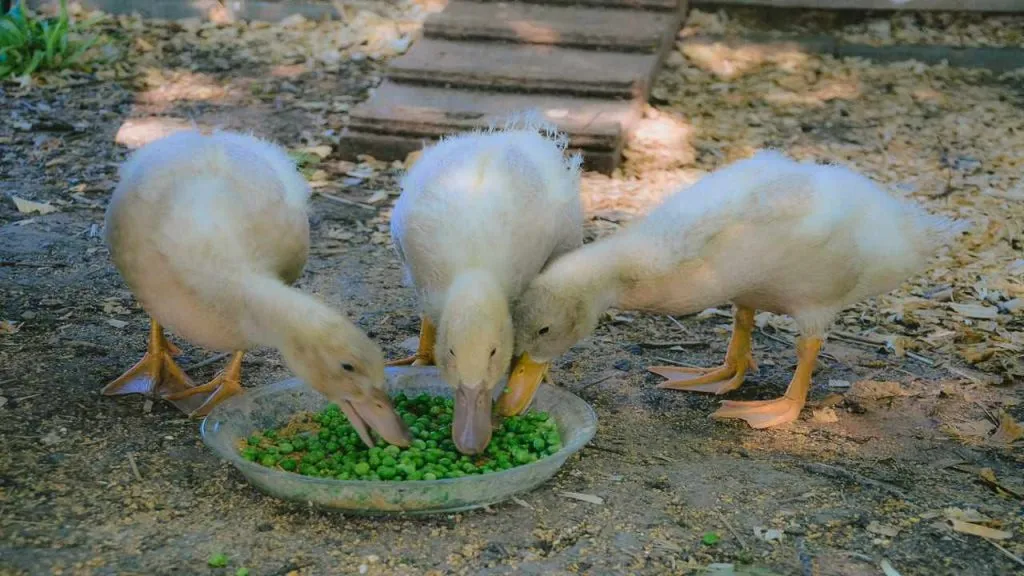As an Amazon Associate I earn from qualifying purchases.
Pekin ducks are popular domestic ducks known for their white feathers and orange bills.
They come from China and are loved all over the world. People like them for their meat and eggs, but they also make great pets and decorations.
Pekin ducks grow quickly and are good for making meat.
Male ducks usually weigh 8 to 11 pounds, while females are a bit lighter.
They also lay a lot of big white eggs. They’re easy to take care of, but it’s important to understand what they eat and how to look after them properly to keep them healthy and happy.
In this guide, we’ll talk about what Pekin ducks eat both in the wild and as pets.
We’ll cover their food requirements at various stages of life, the different kinds of Pekin ducks, how to raise them properly, important care tips, and ways to keep them safe from predators.
Understanding these aspects ensures the well-being of these delightful ducks throughout the year.
What Do Pekin Ducks Eat Throughout The Year?

The food Pekin ducks eat changes depending on whether they live in the wild or with humans.
Let’s take a look at the types of food wild Pekin ducks might eat throughout the year:
1. During the spring and summer months:
- Insects: Mosquitoes, midges, flies, beetles, dragonflies, damselflies, grasshoppers, crickets, and caterpillars are common food sources for ducks.
- Aquatic invertebrates: Ducks may also eat aquatic creatures such as snails, tadpoles, freshwater shrimp, crayfish, and worms.
- Small fish: Ducks feed on small fish like minnows and sticklebacks, which they catch near the water’s surface.
- Plants: Aquatic vegetation including pondweed, duckweed, and watercress, along with terrestrial plants like grasses, sedges, and leafy greens, are part of their diet.
- Seeds: Ducks consume seeds from aquatic plants, grasses, and various wildflowers during this time.
2. During the fall and winter seasons:
- Nuts: Ducks rely on nuts like acorns, beechnuts, and hazelnuts for energy during the colder months.
- Grains: They may also feed on grains such as wild rice, corn, and grains found in fields or at bird feeders.
- Fruits: Continue to eat fruits like berries, grapes, and other available fruits during the fall and winter.
- Aquatic plants: The roots and tubers of aquatic plants become important food sources when other options are limited during this time.
It’s worth mentioning that the diet of wild Pekin ducks changes based on things like where they live, the kind of place they call home, and how food availability changes with the seasons.
Ducks are good at taking advantage of whatever food they can find around them and adjust what they eat depending on what’s available.
Making sure there’s a variety of habitats with different types of food is important for keeping wild duck populations healthy and making sure the natural balance of their environment stays intact.
Learning what Pekin ducks like to eat all year long helps us know what they need to stay healthy, especially as the environment changes.
Now, let’s find out what baby Pekin ducks eat and how their food needs are different from grown-up ducks.
What Do Baby Pekin Ducks?
Just like other ducklings, baby Pekin ducks need special food to help them grow and stay healthy.
They mainly eat a special kind of food called starter duck feed, which is made just for them. This feed has a lot of protein, about 18-20%, which helps them grow strong.
They also need clean water all the time to drink and help with digestion.
Sometimes, they get treats like chopped greens and small insects such as mealworms to give them extra nutrients and make their meals more interesting.
Some duck owners even give them finely chopped boiled eggs for a protein boost.
It’s really important to make sure the food they get is right for their age and needs and to keep their living area clean and warm for their health.
Checking on their growth and behavior regularly helps make sure they’re doing well and getting all the food they need to grow up happy and healthy.
Types of Pekin Ducks
1. Traditional Pekin Ducks: Pekin ducks of the traditional variety are easily identifiable by their immaculate white plumage and striking orange bills and legs, commonly found in both farmyards and backyard environments.
2. Crested Pekin Ducks: On the other hand, Crested Pekin ducks boast a unique genetic feature resulting in a conspicuous tuft of feathers crowning their heads, making them sought after for their decorative charm through selective breeding practices.
3. Jumbo Pekin Ducks: These ducks are bred to be big and heavy so they can be raised for meat. They’re larger than regular Pekins and are popular on meat farms.
4. Long Island Pekin Ducks: Hailing from Long Island, these ducks are renowned for their rapid growth and exceptional meat quality.
Widely favored in meat production, they are prized for their delectable and tender flesh.
5. Miniature Pekin Ducks: These ducks are smaller than the usual Pekins and are loved as pets or for shows because they’re cute and friendly.
Raising Pekin Ducks [The Right Way]
1. Before you start:
- Do your research: It’s important to grasp the responsibility of caring for ducks, which includes understanding their lifespan, what they eat, where they live, and the obstacles they might face.
- Local ordinances: Check local rules about keeping ducks to make sure it’s allowed where you live.
- Prepare your space: Once you’re ready, prepare a safe environment with sturdy fencing, a dry shelter, and access to a small pond or pool.
- Gather supplies: Don’t forget to gather all the necessary supplies like food and water dishes, cozy bedding, heat lamps for ducklings, grit, and any other equipment you might need.
2. Caring for Your Ducks
- Housing: When it comes to caring for your ducks, maintain a clean and dry shelter with plenty of space for them to move around.
- Temperature: Ducklings need warmth, especially when they’re young. Use heat lamps and adjust the temperature as they grow.
- Food: Give them duck food made for their age and growth stage. Always have fresh water available.
- Grit: Offer grit to help them digest food, especially if they spend time outside where they might eat small rocks.
- Supplements: Consider supplements like brewer’s yeast or niacin to support feather growth, especially for ducklings.
- Treats: Treat your ducks occasionally with chopped greens, veggies, or mealworms, but avoid overdoing it
- Foraging: If they can go outside safely, let them look for insects, worms, and plants to eat as extras in their diet.
3. Keeping Your Ducks Healthy and Safe:
- Cleanliness: Keep their living area tidy by cleaning the coop, water dishes, and food containers regularly. This helps prevent illnesses.
- Watchful Eye: Pay attention to your ducks’ behavior and look out for any signs of sickness or injury, like tiredness, not eating, or unusual droppings. If you’re worried, talk to a vet.
- Protection from Predators: Make sure their home is secure to keep them safe from animals like foxes, raccoons, and hawks.
- Pool Safety: If you have a pool, make sure your ducks can get out easily. Providing a ramp or exit point helps them avoid accidents like drowning.
4. More Things to Think About
- Friends for Your Ducks: Ducks love company, so think about having more than one or keeping them with other friendly birds.
- Egg Facts: Understand that Pekin ducks can lay eggs, but the quantity and timing may vary. With proper care, Pekin ducks can live 8 to 12 years, making them a long-term commitment worth considering.
Knowing how to take good care of ducks sets the stage for raising Pekin ducks well and making sure poultry farming is sustainable.
Let’s talk about what Pekin ducks need to eat when they’re kept as pets and what foods make them healthy and happy.
The Essentials Pekin Ducks Need What To Feed Them As Pets

Pekin ducks, as pets, require a balanced diet to thrive. Their diet should consist primarily of commercially formulated duck pellets or crumbles, providing essential nutrients like protein, vitamins, and minerals.
Additionally, they benefit from fresh greens such as lettuce, spinach, and kale, along with occasional treats like mealworms or cracked corn.
Access to clean water for drinking and bathing is crucial for their well-being, as ducks enjoy splashing and preening to maintain their plumage.
And it’s important to monitor their food intake, ensuring they receive adequate nutrition without overfeeding, which can lead to health issues.
Avoid giving ducks bread, crackers, chips, candy, sugary treats, citrus fruits, avocado, onions, and garlic because these foods can make them sick.
Citrus fruits can upset their stomachs, and avocado, onions, and garlic are poisonous to ducks. Choose healthier foods to keep your ducks safe and happy.
Adjust food amounts, avoid overfeeding, introduce new foods slowly, and consult a vet if needed.
Overall, a varied diet, clean water, and proper portion control are essential for the health and happiness of Pekin ducks kept as pets.
Are Pekin Ducks Preyed Upon by Any Animals?
Regrettably, Pekin ducks face threats from various animals both in the wild and captivity. Some common predators include:
1. In Natural Habitats
- Birds of Prey: Larger birds like eagles, and owls are capable of seizing smaller ducks or ducklings.
- Mammals: Carnivorous mammals such as coyotes, bobcats, and others are skilled hunters, especially targeting ducklings and eggs.
- Reptiles: Snakes and sizable lizards can harm young ducklings or their eggs.
- Fish: In some cases, larger fish may pose a threat to ducklings near water edges.
2. In Captivity
- Domestic pets: Dogs, cats, and even big rodents without supervision can injure or fatally harm ducks.
- Wild predators: Even within enclosures, persistent predators like raccoons or foxes might find ways to access the ducks.
3. Factors That Affect Vulnerability
Several factors increase the chances of ducks being targeted by predators.
Ducklings, being smaller and less able to defend themselves, are especially vulnerable compared to adult ducks.
Ducks that are sick or injured are also more likely to be attacked by predators.
The strength of enclosures matters too; predators can easily get in if they’re weak or poorly made.
Plus, ducks left alone without supervision are at higher risk, emphasizing the need for careful watching to keep them safe.
Duck owners need to keep their Pekin ducks safe from predators by making sure their enclosures are secure, using fencing that keeps predators out, and watching over them carefully, especially when they’re most at risk.
Conclusion
In summary, knowing what Pekin ducks need to eat and how to take care of them properly is crucial for keeping them healthy, happy, and around for a long time.
By giving them the right food, a good place to live, and regular check-ups from the vet, you can enjoy the company of these delightful birds for many years.
FAQs:
Pekin ducks typically eat about 0.5 to 1 pound of food per day per adult duck, depending on factors like their size, age, and activity level.
Pekin ducks can weigh anywhere from 8 to 11 pounds on average, with males usually being heavier than females.
Pekin ducks make a variety of sounds, including quacks, honks, and grunts.
They use different vocalizations to communicate with each other and express emotions like contentment, excitement, or distress.
Amazon and the Amazon logo are trademarks of Amazon.com, Inc, or its affiliates.

